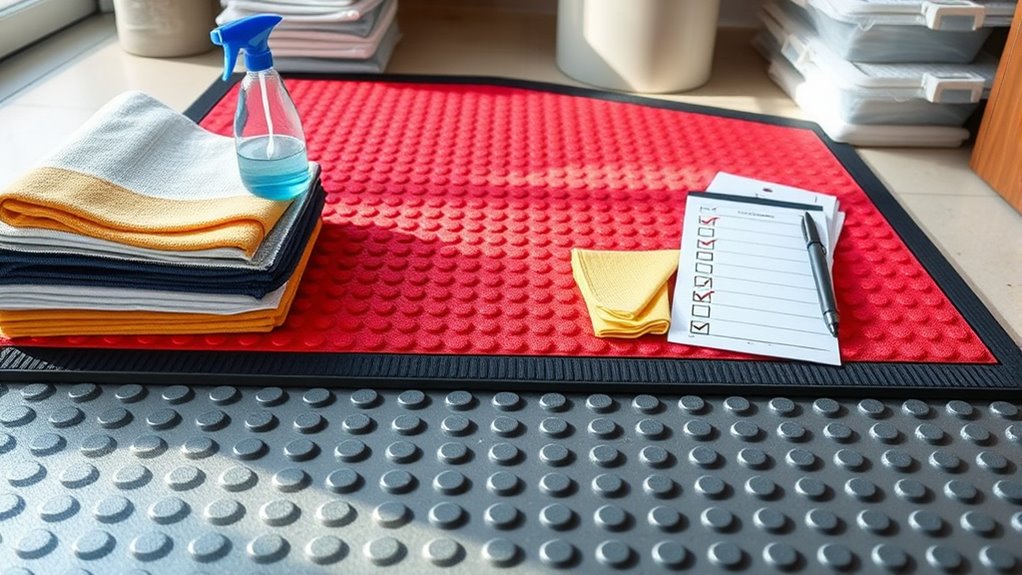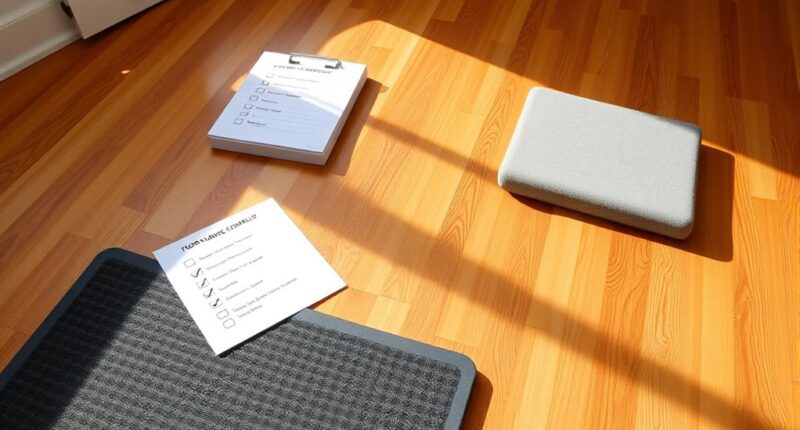Before you start, create a floor protection and mats maintenance checklist by identifying high-traffic areas and placing mats strategically, especially at entry points. Regularly clean and inspect your mats to remove dirt and debris, and choose appropriate cleaning methods for your flooring type. Maintain a routine that includes gentle sweeping, mopping, and occasional polishing to keep surfaces looking fresh and in top condition. Keep these tips in mind, and you’ll guarantee your floors and mats stay durable and long-lasting.
Key Takeaways
- Assess high-traffic areas and strategically place mats to prevent dirt and damage.
- Regularly vacuum or shake out mats to remove loose dirt and debris.
- Use appropriate cleaning solutions for both mats and flooring to avoid damage.
- Inspect mats and floors frequently for wear, stains, or deterioration, and address issues promptly.
- Follow tailored maintenance routines for specific flooring types to preserve appearance and lifespan.
Floor and Mat Care Essentials

Maintaining your floors and mats is vital to preserving their appearance and extending their lifespan. When you prioritize proper care, you help guarantee that your surfaces stay looking fresh and functional for years to come. One of the most effective ways to do this is by focusing on flooring durability and mastering the right mat cleaning techniques. These practices not only keep your spaces clean but also protect your investment in quality flooring and mats, saving you money on repairs or replacements down the line.
Start by understanding the significance of flooring durability. Different materials require specific maintenance routines to stay resilient against wear and tear. For example, hardwood floors benefit from gentle sweeping and periodic polishing, while tile or vinyl might need regular mopping with suitable cleaners. By tailoring your approach, you prevent scratches, stains, and other damage that can compromise the integrity of your floors. Consistent maintenance creates a protective barrier that preserves their original look and structural strength.
Different flooring materials need tailored maintenance to prevent damage and preserve their strength.
In addition, proper mat cleaning techniques are vital for maintaining both cleanliness and functionality. Mats trap dirt, moisture, and debris, preventing these elements from spreading throughout your space. To keep mats effective, you should vacuum or shake them regularly to remove loose dirt. For deeper cleaning, use a mild detergent mixed with water or a specialized cleaning solution designed for your mat material. Avoid harsh chemicals that could degrade the fibers or cause discoloration. Make sure to thoroughly dry the mats after cleaning to prevent mold and unpleasant odors. These simple steps will extend the lifespan of your mats and maintain their ability to protect your floors effectively. Additionally, employing proper cleaning techniques can help preserve the color accuracy and surface quality of your mats and floors.
It’s also important to place mats strategically in high-traffic areas, such as entryways and hallways, to minimize dirt and moisture being tracked in. Encourage family members or employees to wipe their shoes before stepping onto your main flooring. Regularly inspect your mats and floors for signs of damage or excessive dirt buildup, addressing issues promptly before they escalate. This proactive approach guarantees you’re not only cleaning but also preventing long-term deterioration.
Frequently Asked Questions
How Often Should I Replace My Floor Protection Mats?
You should replace your floor protection mats based on their durability and how often they’re used. Generally, for high-traffic areas, mats may need replacement every 6 to 12 months. If you notice signs of wear, tearing, or decreased effectiveness, it’s time for a new one. Regular inspection helps maintain ideal floor protection, ensuring your mats provide reliable durability and save you money in the long run.
Can Certain Cleaning Products Damage Floor Mats?
Did you know that using the wrong cleaning product can reduce your mat’s lifespan by up to 50%? Yes, certain cleaning product compatibility issues can damage your mats, especially if they aren’t designed for specific materials. Always check for mat material safety and choose cleaning products that are compatible. This prevents deterioration, preserves effectiveness, and prolongs your mats’ durability, saving you money in the long run.
Are There Eco-Friendly Options for Floor Protection Mats?
Yes, eco-friendly options for floor protection mats exist. You can choose biodegradable options that break down naturally over time, reducing environmental impact. Additionally, mats made from recycled materials like rubber or plastic help repurpose waste and promote sustainability. When selecting mats, look for products labeled as eco-friendly or sustainable, ensuring you protect your floors while supporting environmentally conscious practices.
How Do I Prevent Mats From Slipping or Sliding?
Imagine slipping on a wet floor—dangerous and frightening. To prevent mats from slipping or sliding, use a mat grip or apply anti-slip coatings. For example, a busy café owner secured mats with a high-traction grip, reducing accidents substantially. Regularly check and clean the underside of your mats to keep the grip effective. These simple steps keep you safe and your mats firmly in place.
What Is the Best Way to Store Seasonal Floor Mats?
To store seasonal floor mats properly, follow these storage tips for seasonal mat care. Clean them thoroughly and let them dry completely to prevent mold. Roll or fold the mats carefully, avoiding creases, and store them in a cool, dry place away from direct sunlight. Use airtight containers or plastic bins to protect against dust and moisture. This guarantees your mats stay in good condition until you need them again.
Conclusion
Now that you’ve got the essentials down, keeping your floors and mats in top shape is a breeze. Regular maintenance and protection prevent issues before they start, saving you time and money. Remember, a stitch in time saves nine—staying proactive keeps everything running smoothly. Stick to your checklist, and your floors will stay pristine and safe, letting you focus on what truly matters. Keep up the effort, and your space will shine for years to come!









